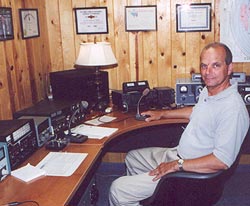|
United We Stand |
|
|
Brainerd Area Amateur Radio Club, Inc. |
|
THE AMATEURS CODE by Paul M. Segal, W9EEA (1928) |
The
Radio Amateur is:
CONSIDERATE..... never knowingly operating in such a way as to lessen the pleasure of others.
LOYAL..... offering loyalty, encouragement and support to other amateurs, local clubs and the American Radio Relay League, through which Amateur Radio in the United States is represented nationally and internationally.
PROGRESSIVE..... with knowledge abreast of science, a well built and efficient station, and operation beyond reproach.
FRIENDLY..... with slow and patient operation when requested, friendly advice and counsel to the beginner, kindly assistance, co-operation and consideration for the interests of others. These are the hallmarks of the amateur spirit.
BALANCED..... Radio is an avocation, never interfering with duties owed to family, job, school or community.
PATRIOTIC..... with station and skill always ready for service to country and community.
NEWINGTON, CT, Oct 9, 2002--FCC Special Counsel Riley Hollingsworth has endorsed a list of several points that he feels help to define the concept of "good amateur practice." Section 97.101(a) of the Amateur Radio Service rules refers to "good engineering and good amateur practice"--considered to refer to maintaining the highest standards of engineering and on-the-air comportment. But the rule lacks specifics.

Riley Hollingsworth, K4ZDH, at home in his well-equipped shack, which includes a mixture of both modern and vintage gear. |
"Good amateur practice is a hard thing to define," Hollingsworth conceded. "I'd have to say it's operating with the realization that frequencies are shared, that there's going to be occasional interference and that's no reason to become hateful and paranoid."
Hollingsworth says amateurs have to realize that more people than ever are listening in, especially since September 11, 2001, and that amateurs always need to remember that "our rights end where another person's begin."
A Michigan Amateur Radio club has been credited with distributing a list of "Riley-isms" culled from Hollingsworth's various talks at conventions and hamfests and club meetings around the US. Hollingsworth--who verified that he had been cited accurately--says his various comments represent an effort to flesh out what "good amateur practice" consists of for considerate the Amateur Radio operator.
According to Hollingsworth, good amateur practice means:
| Giving a little ground--even if you have a
right not to--in order to help preserve Amateur Radio and not cause
it to get a bad name or hasten the day when it becomes obsolete.
Respecting band plans, because they make it possible for every mode to have a chance. Not transmitting a 6-kHz bandwidth signal when there are lots of people on the band. Not acting like an idiot just because you were stepped on. Being aware that we all love Amateur Radio, and there's no need to damage or disgrace it just to save face. Keeping personal conflicts off the air. Settle your arguments on the telephone, the Internet or in person. Just keep them off the air. Cutting a net or a contester a break, even if you don't have to and even if you have no interest whatsoever in nets or contesting. Operating so that if a neighbor, niece or nephew or news reporter hears you, that person will be impressed with Amateur Radio. Realizing that every right carries responsibilities, and just because you may have a right to do certain things doesn't mean it's right to do them in every circumstance. You don't "own" or get preference to use any frequency even though you've been on the same spot every morning for years shooting the breeze with Harry. Not operating so that whoever hears you becomes sorry they ever got into Amateur Radio in the first place. |
Hollingsworth notes that the list "doesn't touch on a lot of other technical issues, such as using 1500 W when your signal report received is 40 over 9." Good amateur practice, he said, "just means a lot of things that can't always be quantified."--thanks to Riley Hollingsworth
Reprinted from the ARRL website
|
Good Operating Practice |
9-7-2003:
When operating HF, VHF, or even UHF, be sure to leave a second or so
between transmissions so anyone wishing to break-in can do so.
That break-in could even be emergency traffic.
Mark WØMH
2-1-2005: FCC rules require that we use call sign identification every 10 minutes and at the end of a QSO. The rules do not require an ID at the beginning of a transmission although that is common courtesy. It is important to note that you should make your call sign the last thing you say when checking in on the Sunday Night Net. A full call sign is also required when doing a simplex check-in or even a brief check-in on the 440 Net. Mark WØMH
10-04-2005: Don't Mumble: As hams, we learn to communicate. To be effective communicators, we need to be heard clearly. So, speak clearly and distinctly. Proper microphone technique is part of this. Try different microphone positions and have other operators comment how easily they can copy you. Yes, you know what you are saying, but others may not hear you clearly enough to get the full meaning of what you are saying. Radio broadcast announcers “modulate” their voices for consistent level so they can be understood, even in noisy environments. You can too. It is good operating practice. Mark WØMH
This page was last updated 02/16/2009 Ø